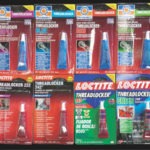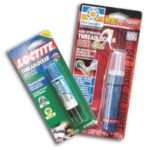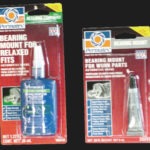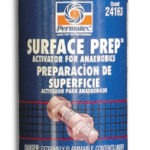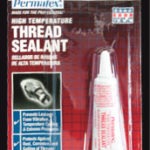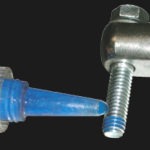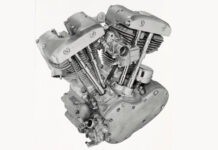Although the moniker “Milwaukee Vibrator” is rapidly becoming obsolete thanks to H-D’s advances in vibration control, it is still in your interest to regularly check the various and nefarious fasteners that hold the scoot together. It’s also worthy of note that even a casual observation of the factory fasteners will demonstrate The Motor Company’s decreasing reliance on old-fashioned lock-washers and an almost complete conversion to fasteners that come new with a dab of some sort of threadlocker on them instead.
The short answer to the question, “Why threadlockers?” has to do with the fact that trying to properly tighten a nut or bolt to a specific torque value (let alone an unknown one) is an inconsistent, erratic process at best. Getting any fastener to do its job faithfully, in spite of vibration and heat (meaning expansion, contraction and outright distortion in dissimilar metals) can be very tricky.
First, we have to deal with the basic concept of how a bolt, screw or practically any other threaded fastener really works. Come right down to it, they all function on the physics of tension (stretch and elasticity), not shear (sideways or lateral loading). In other words, the proper function of a bolt, let’s say, depends on its ability to clamp parts together, not to hang ’em like a picture from a wall.
Coupled with this fact is the insufficient practice of attempting to get the precise amount of stretch required for a particular fastener to do its job without fail (or failing!) by using a torque wrench. For instance, is that supposed to be “dry” or “wet” torque? To get the same amount of stretch from a given fastener, the difference between wet and dry can require an increase in torque of anything from 20 percent to over 100 percent! In fact, depending on the material the fastener is made of and the coating on it, it might even require a reduction in torque setting to work. Re-using a fastener just complicates things further. Still, imperfect as it may be, using a torque wrench to snug up a bolt on your hog remains the accepted method of getting it done the way the shop manual usually specifies it be done—for bolts, anyway. Screws frequently don’t have specified torque values at all! And reusing fasteners that are worn, dirty or whatever came out of the hardware jar on your workbench just makes for way too much guesswork when it comes to critical fasteners, wouldn’t you say? (And on a Harley, what fastener isn’t critical?)
The Motor Company understands this issue pretty well, and is moving more and more toward more sophisticated fastener tightening techniques that create the proper stretch in everything from head bolts to compensators, to pulley nuts, via multiple-step “rotational” methods. Harley is relying less and less on traditional torque settings and more and more on threadlockers.
Knowing that, consider what happens when you are bolting things to your bike the old-fashioned way. The reality, regardless of the reading on your wrench, can be anything from, say, 16-24 ft/lbs on a typical 5/16” fastener (if it’s even in that ballpark when you’re finished). Not the most accurate gauge of fastener stretch, considering there’s as much as a 50 percent variance involved! If you aren’t using a torque wrench, there’s simply no telling. We’re talking about regular stuff like fender bolts, too. Being that vague about proper tightening of more important hardware is basically unacceptable. Because of vibration, heat, cold and who knows what sort of demands on the fasteners, you can only hope things will stay put—torqued or not.
So, knowing it’s not quite as scientific and precise a process as it should be, how do you cover your bets and go from hope to near certainty? Arguably the best way, bar none, is to apply a little dab of anaerobic liquid resin.
Invented in the basement of a Trinity College chemistry professor and his son Robert back in 1953, the stuff came to market in 1956 known by the name coined by Robert’s wife—”Loctite.” Today, there are plenty of companies making this magic in a bottle. Although Permatex and Loctite are the most famous, there are many makers of these sealants and adhesives that harden and expand in the absence of air. They are readily available in several different strengths and for practically any automotive application you can name. What makes these anaerobic so-called threadlockers so indispensable is this ability to dry and adhere to metals, particularly threaded metals, in microscopic spaces.
In virtually every case where sheer heat (more than 400 degrees or so) doesn’t preclude its use, the factory recommends the use of a particular grade of threadlocker that’s suited to the specific task. One major reason (aside from vibration-proofing) is that threadlockers will tolerate a little variance in torque and help compensate for slight irregularities in stretch from one fastener to another.
It’s simple; using the right grade of threadlocker, in the right applications and in the right way, is the best insurance that your hardware will stay attached, with or without a traditional torque value and in spite of vibration and/or temperature changes. It’s a major help (and minor miracle)! So sit tight and lock on for a basic rundown on using threadlocker to tighten up your ride.
No matter what the brand (in this case Permatex and good ol’ Loctite), threadlocker comes color-coded to make the right choice easier. For nearly any motorcycle application, all you need to remember is that low-strength “Purple” is for fasteners less than 1/4” in diameter and easily removable. “Blue” is the ubiquitous so-called medium strength stuff, removable with hand tools and the workhorse of the bunch. The really strong (practically permanent) grade is “Red” and when they say it takes “extra effort” to remove stuff stuck on with this, it’s usually an understatement! “Green” is the least appreciated and that’s a pity because it should be the one we reach for before we are in a situation that requires re-attaching anything, since a drop or two will even penetrate into the threads of fasteners already in place—and keep ’em in place—in the first place!
Anaerobic liquid resin isn’t just thread juice in a tube anymore, either. These days it comes in tidier, handier, less wasteful guises, such as convenient gel sticks, which apply a more even coat on fastener threads before they go into service—without dripping!
There’s more to it than meets the eye when it comes to non-threaded applications, as well. For instance, these two tubes by the same manufacturer (Permatex) contain similar sealants, but they are definitely not for the same uses. The one on the left can do things like replace snap rings and set screws, restore fit on press fit bearings and add up to 2,800 PSI shear strength on steel. The tube on the right fills gaps of up to 0.020”, withstands temps of 300 degrees and adds as much as 3,000 PSI of holding power. Like the labels imply, one is for situations where things maybe aren’t quite as tight as they should be. The other is to hold parts together that are flat worn out, and keep ’em in service long enough for new parts to arrive.
Of course, using fasteners without threadlocker is like using threadlocker without Surface Prep—results aren’t nearly as good. Should you think this stuff doesn’t matter, perhaps you should be aware that, especially in cold weather, it not only cleans the threads like a good solvent but actually speeds up the cure time of the threadlocker by 50 percent. Good to know when you need to get back on the road in a hurry.
Among the many OEM (as in Harley-Davidson) specified liquid tools you should have in your toolbox is High-Temperature Thread Sealant (also referred to as PTFE) for applications like oil pipe fittings, cooler lines, switches and sensors and a host of other situations where you need to screw a fine-thread fitting into a no-leaks-allowed hole.
By now, it should be obvious that there are literally dozens of specialized anaerobic resins for the hundreds of fasteners that perform thousands of thankless tasks on your hog. It pays to do the research and find the one best suited to your particular project and situation. Although some aren’t even applied in the traditional way you see here, there has never been more need for the technology these threadlockers bring to the table than there is nowadays (being especially mindful of the miraculous feats they can perform on old Harleys). Since there are OEM-specified uses all over the machine, there’s no better time to start doing the job right, using the proper (anaerobic) tools.





